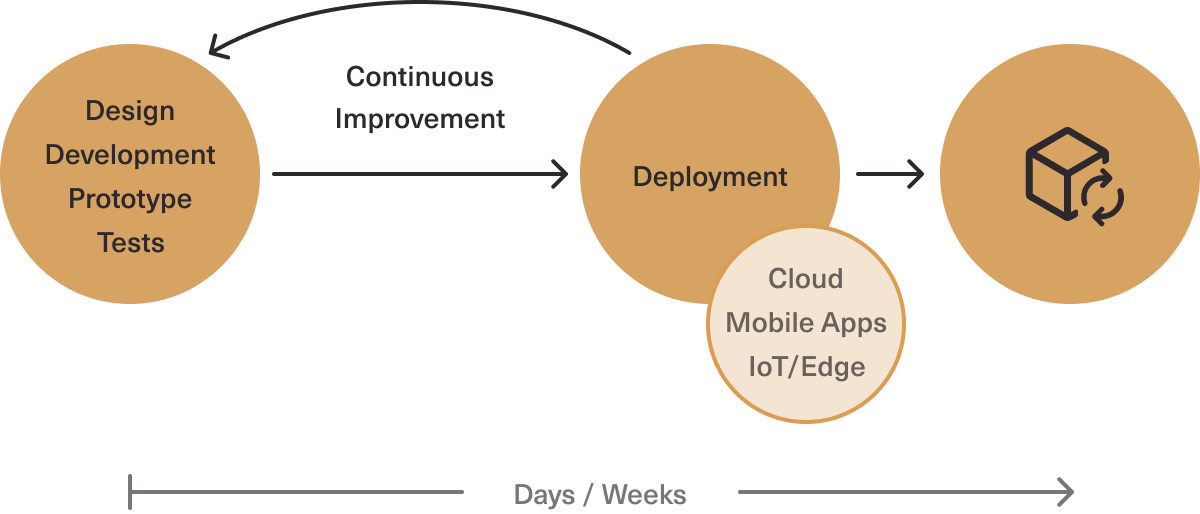Unlocking the Software Mutation Superpower for Connected Equipment [2/6]
Software Superpower Series Part 1: Mutation
Software transformation is disrupting manufacturing. The digital revolution and its innovations (robotics, cloud computing, the Internet of Things, etc) continues to play a central role in the natural evolution of the sector. Software is now an integral aspect of the industry as it reinvents traditional processes.
Still, manufacturing is an industry that produces physical products. Any integrated software must complement the product — and more importantly, vastly improve the customer experience. Yes, improvements to internal operations are needed. But the real superpower of software is how it can cultivate user benefits (e.g., convenience, speed of delivery). In today’s digital transformation race, positive consumer interactions make all the difference.
So how can manufacturers with connected equipment effectively leverage software for such a competitive edge? Read on to discover how you can improve your business with the first software superpower in the software superpower series: mutation.
Mutation: The Capability To Alter Your Product DNA
Mutation refers to the alteration of a distinct form or structure. The term is most often used in biology to describe the changes that occur in genes. Random mutations occur in DNA and pass down to the following generation. Natural selection always prefers mutations that offer the best odds of survival, so with enough time, an improved version of the organism emerges.
Software follows a similar evolution process. Changes and improvements to the base structure can result in a better version. But unlike in biology, software evolution is not the result of uncontrolled or randomized changes. With digital tools, you can select which elements to include or reject. And with the speed of software, you complete those transformations far faster.
To complete the analogy, the consumer market will determine which items survive. Whoever evolves the product the market wants earns an unfair advantage over competitors (reports show that 73% of surveyed consumers point to the customer experience as a crucial factor in buying decisions). Software that can apply numerous mutations (improvements) develops a product with a superior customer experience — it will survive.
And customers now expect this type of evolution and service. Many users have grown accustomed to the rapid upgrades and updates provided via smartphones and other Saas services. Command market share with an evolved product that satisfies the consumer.
Physical Vs Software Evolution
Most manufacturers have already utilized manual mutations to enhance items for years. Digital tools simply supercharge this normal evolution. Let's compare both processes to better illustrate the benefits of software mutation.
The Physical product manufacturing process
Physical manufacturing evolution follows well-known production systems. Mutations can and do occur, but they are slow and cumbersome events. For example, if you identify a possible improvement, you must fabricate a brand-new item. That requires time and resources. Often, the entire creation process must restart from step one with the design phase.
Plus, when an item ships, the evolution process stops (and in fact deteriorates). It is very difficult to update or improve delivered items. Case in point, consider a car recall, where a completed product suffers from an unexpected flaw. Upon discovery, the manufacturer must go through a labor-intensive mutation process. Customers must be contacted, appointments scheduled, a fix or new prototype developed, and the item repaired or, worse, fabricated again. Mutation and improvements occur, but it is a costly endeavor.
Once your product is built and shipped, it stops evolving. Worse, it begins to deteriorate, probably. Consequently, when a critical flaw is identified, or an improvement is required, a new item has to be fabricated, or a fix needs to be made on each produced device individually. An example to illustrate this is car recalls, when car manufacturers and their dealers must reach out to all their customers, schedule an appointment and fix a manufacturing flaw at a very high cost.
The Digital product “continuous improvement” process
Digital products have similar upstream phases to physical process evolution (e.g. visioning and prototyping still involve the same human inputs). But software evolution becomes a true superpower due to its ability to continuously deploy.
Technology can automatically develop, build, and test product elements without time lag. The product engages in a non-stop process of evolution. As you build, simultaneously test for errors, make changes based on data reports, and ensure constant provisioning. The software creates a feedback loop that never stops evolving on itself.
Plus, the evolution process does not stop, even after delivery to the consumer. Think of how easy it is to update thousands of equipment pieces or devices with just the push of a button. You could completely alter a web application with improved code. You could deliver customer experience service upgrades to mobile apps through Apple or Google stores. Or you could send over-the-air updates for connected equipment (IoT).
In short, offer your customer a “new, evolved version” — but with no physical change to the product. It is an efficient and cost-effective way to upgrade the item and the customer experience.
On the other hand, developing digital products involves a different process. It has similar upstream phases, like creating a vision and prototyping. The key difference compared to physical product development is the possibility of continuously “deploying new versions.”
“Deploying” can take different forms, such as updating server code for a web application, pushing an update in Apple and Google stores for a mobile application, or pushing an over-the-air update for connected equipment (IoT). “New version” means the same “instance” of software evolves—no need to physically change individual items or build new ones.
Imagine automatically and flawlessly updating thousands of pieces of equipment and devices simultaneously to exhibit a new, more helpful behaviour with just the push of a button.
Real-world example: Tesla Car Recall
Tesla shows the power of a software evolution process. The car manufacturer found a critical flaw in its self-driving system. While the press labeled the issue a “recall,” Tesla resolved the problem with a simple software update. The digital fix could then be pushed over the air, involving none of the usual costs of a traditional car recall.
IoT Platform Use Case
INGENO recently collaborated with a research center on implementing a state-of-the-art multi-tenant IoT platform allowing its customers to manage fleets of connected equipment like sensors and video streaming devices on AWS IoT Core.
As described in this article, using fully automated software lifecycle techniques and methodologies – sometimes delivering multiple updates on a single day – INGENO enabled continuously updating digital experience to its customers and users, a central requirement.
View case studyHow Can You Benefit from this Superpower?
You can implement your own software evolution processes with a fully automated software delivery cycle (SDLC). An SDLC refers to the stages of product creation, but each stage occurs in a continuous cycle. As you build, mutations occur through a neverending feedback loop. Your products never finish, they just continue to adapt to the needs of your market. Constant changes help you determine the most efficient manner of production, and it delivers a product according to customer expectations.
For example, an SDLC automates your software quality assurance and deployment. Continuous testing tools catch errors during fabrication. Your internal processes and the product continue to upgrade, leading to immediate improvements in efficiency. Automation will also replace labor-intensive manual processes for better flexibility and cost savings.
More importantly, an automated SDLC allows you to distribute changes - aka mutations - to your products. It is a high-quality, high-frequency, and low-risk way to deploy improvements to your ecosystem. IoT technology can easily send over-the-air updates to devices on the edge, and that makes all equipment behavior mutable. Physical products can now continue to evolve, even after final delivery. Modern items never finish, they just continue to adapt. An SDLC helps you deliver on those customer-demand changes.
Conclusion
Manufacturers can leverage the superpower of software mutation to improve operations and achieve a better customer experience. In the current digital revolution race, such advantages are crucial.
Contact Guillaume today to learn how we can help you maximize the Mutation superpower for your business.
At INGENO, an AWS select consulting partner, we specialize in helping companies create revenue-generating IoT, web and mobile digital products. We are passionate about taking full advantage of software superpowers for our customers.
Contact meComing up
In my next article, I will describe another software superpower: the power of Software Scalability. Stay tuned!




